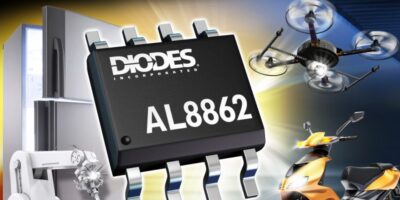To support 48V high-performance graphics processing units (GPUs) in data centres that rely on legacy 12V power distribution, Vicor has announced a 12 to 48V non-isolated up converter, the 2317 NBM.
It converts 12 to 48V with over 98 per cent peak efficiency, 750W continuous and 1.0kW peak power in a 23 x 17 x 7.4mm surface-mount SM-ChiP package.
The NBM (NBM2317S14B5415T00) does not require external input filter or bulk capacitors, says Vicor. By switching at 2MHz with zero voltage switching (ZVS) and zero current switching (ZCS), the NBM provides low output impedance and MHz fast transient response to dynamic loads. The NBM incorporates hot-swap and inrush current limiting, adds Vicor.
The NBM supports 48V input GPUs using Power-on-Package (PoP) Modular Current Multipliers (MCMs) driven from a 48V node sourcing a small fraction (1/48) of the GPU current. Current multiplication overcomes the power delivery boundaries imposed by traditional 12V systems standing in the way of higher bandwidth and connectivity to meet the demands of increased data centre traffic.
Vicor PoP modules build upon Vicor’s Factorized Power Architecture (FPA) systems deployed in high-performance computers and large-scale data centres. FPA provides efficient power distribution and direct conversion from 48 to 1.0V for GPUs, CPUs and ASICs demanding up to 1000A. By deploying current multiplication in close proximity to high current artificial intelligence (AI) processors, PoP MCMs enable higher performance and system efficiency to handle increased connectivity in applications such as autonomous vehicles.
Vicor designs, manufactures and markets innovative, high-performance modular power components, to enable customers to efficiently convert and manage power from the power source to the point of load (PoL).
Vicor’s Power Component Design Methodology enables power system designers to reap all of the benefits of modular power component design – predictable component and system functionality and reliability, fast design cycles, and easy system configurability, re-configurability and scaling – while achieving system operating efficiency, power density and economy that rival the best alternative solutions.
Utilising Vicor’s Power System Designer, engineers can select from an extensive portfolio of proven Vicor power components to architect, optimise and simulate the complete power system, all the way from their input sources to their points of load. This approach to power system design delivers fast time-to-market and state-of-the-art performance, says Vicor, while minimising the possibility of last minute surprises and delays that so often occur with conventional or custom design methodologies.







